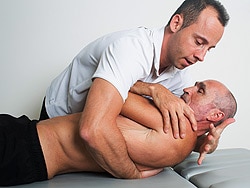I have shared with you in previous BLOGS the incredible benefits of spinal adjustments:
- https://charlesseminars.wordpress.com/2016/10/29/americas-opioid-addiction/
- https://charlesseminars.wordpress.com/2016/08/01/how-does-a-chiropractic-adjustment-work-and-why-is-it-so-important-to-overall-health/
A landmark paper that came out today in Medscape Orthopedics had this to say:
"Spinal Manipulation: A Valid Technique?
In her office at McMaster University in Toronto, Anita Gross, MSc, has logged paper after paper showing that spinal manipulation can help control neck pain. "The evidence keeps growing and growing," she says.
Gross, a physiotherapist and associate professor of rehabilitation science, helped write a 2015 Cochrane review of the literature and is already at work on updating that paper.[1]
 |
Mounting evidence also supports spinal manipulation for low back pain, says Roger Chou, MD, professor of medicine at Oregon Health & Science University in Portland, Oregon, who led a similar review for the Agency for Healthcare Research and Quality last year.[2]
Contemporary theories on the mechanism of spinal manipulation include the disruption of articular or periarticular adhesions; release of entrapped synovial folds; unbuckling of motion segments that have undergone disproportionate displacements; relaxation of hypertonic muscle; alteration of mechanoreceptors in the spinal apophyseal joints; and release of endorphins.[6]
However spinal manipulation works, it's at least better than nothing when it comes to chronic low back pain, says Dr Chou. "Our general finding was that manipulation appears to be more effective than treatments that are thought to be basically control treatments—such things as pretend ultrasound or giving somebody an educational booklet," he explains."
*If you would like the full article sent to you please respond here and I will have it forwarded to you.

Here are the references from the Medscape Article if you would like to investigate further:
References
- Manipulation and mobilisation for neck disorders. Cochrane. September 23, 2015. http://www.cochrane.org/CD004249/BACK_manipulation-and-mobilisation-neck-disorders Accessed January 26, 2016.
- Noninvasive treatments for low back pain. Agency for Healthcare Research and Quality. February 29, 2016. http://effectivehealthcare.ahrq.gov/index.cfm/search-for-guides-reviews-and-reports/?productid=2192&pageaction=displayproduct Accessed January 26, 2016.
- Homola S. Bonesetting, chiropractic, and cultism. Chirobase. 1963. https://www.chirobase.org/05RB/BCC/01.htmlAccessed January 26, 2016.
- Wieting MJ. Massage, traction, and manipulation. Medscape. November 2, 2015. http://emedicine.medscape.com/article/324694-overview#a4 Accessed January 26, 2016.
- Keating JC Jr. D.D. Palmer's religion of chiropractic. Chiro.org. March 1995. http://www.chiro.org/Plus/History/Persons/PalmerDD/PalmerDD's_Religion-of-Chiro.pdf Accessed January 26, 2016.
- Cugalj AP, McManus K. Manual treatments. PM&R Knowledge Now. September 20, 2013. http://me.aapmr.org/kn/article.html?id=56 Accessed January 26, 2016.
- Neck pain tool-kit: step 1. Physiopedia. http://www.physio-pedia.com/Neck_Pain_Tool-kit:_Step_1 Accessed January 26, 2016.
- Low back pain strategy. Ontario Ministry of Health and Long-Term Care. September 16, 2016. http://health.gov.on.ca/en/pro/programs/ecfa/action/primary/lower_back.aspx Accessed January 26, 2016.
